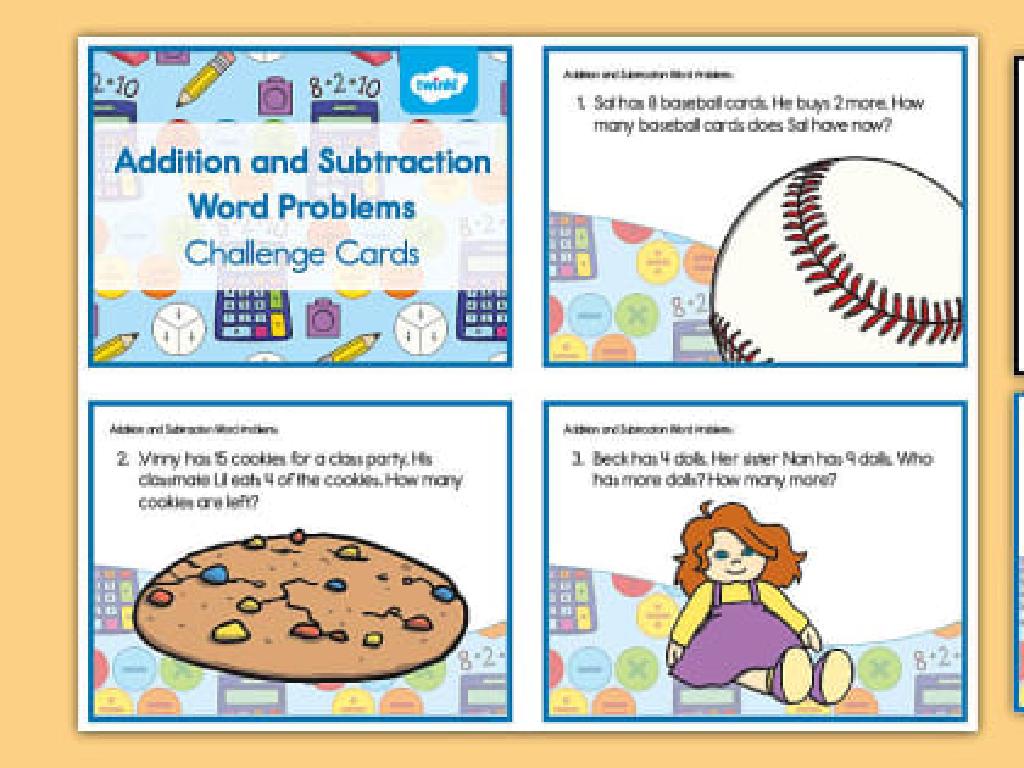Multiply Three Or More Mixed Numbers, Fractions, And/Or Whole Numbers
Subject: Math
Grade: Sixth grade
Topic: Multiply Fractions
Please LOG IN to download the presentation. Access is available to registered users only.
View More Content
Multiplying Fractions: Getting Started
– Welcome to fractions multiplication!
– Understanding fractions basics
– Fractions represent parts of a whole
– Today’s goal: multiply mixed numbers
– Learn to multiply 3+ mixed numbers, fractions, and whole numbers
– Combining fractions and whole numbers
– Practice with examples: 2/3 x 3/4 x 2, 1 1/2 x 2/5 x 5
|
This slide introduces students to the concept of multiplying fractions, mixed numbers, and whole numbers. Begin by ensuring students are comfortable with what fractions represent and how they are used to express parts of a whole. The main objective of today’s lesson is to teach students how to multiply three or more numbers that may include mixed numbers, fractions, and whole numbers. Provide clear examples and step-by-step instructions to demonstrate the multiplication process. Encourage students to participate by solving examples together and emphasize the importance of understanding the process rather than just memorizing steps.
Review: Multiplying Two Fractions
– Steps to multiply fractions
– Multiply the numerators, then the denominators
– Example: Multiply 1/2 by 3/4
– 1/2 * 3/4 = (1*3)/(2*4)
– Simplify the product
– Reduce 3/8 to its simplest form
|
Begin with a quick review of the process for multiplying two fractions to ensure a strong foundation before moving on to more complex problems involving three or more mixed numbers, fractions, and/or whole numbers. Walk through the example on the slide, multiplying the numerators (1 and 3) to get 3, and the denominators (2 and 4) to get 8, resulting in the fraction 3/8. Emphasize the importance of simplifying fractions to their lowest terms, although in this case, 3/8 is already in its simplest form. This review sets the stage for understanding the multiplication of multiple fractions, which is a key skill in many areas of mathematics and real-life applications.
Multiplying Mixed Numbers
– Understanding mixed numbers
– A number with a whole part and a fraction part, e.g., 2 1/3
– Convert to improper fractions
– Change mixed numbers to fractions: 2 1/3 becomes 7/3
– Example: 2 1/3 x 1 1/2
– Multiply 7/3 (2 1/3) by 3/2 (1 1/2)
– Multiplication process
– Multiply numerators, then denominators, simplify if needed
|
Begin by explaining what a mixed number is, ensuring students can identify the whole number and fractional parts. Demonstrate how to convert mixed numbers into improper fractions, which is a crucial step before multiplication. Use the example 2 1/3 multiplied by 1 1/2 to show the process in action. Convert both mixed numbers to improper fractions, then multiply the numerators together and the denominators together. Finally, simplify the resulting fraction if possible. Encourage students to practice this method with different numbers to gain confidence.
Multiplying Three Fractions
– Steps to multiply fractions
– Multiply numerators together, then denominators.
– Example: 1/2 x 2/3 x 3/4
– (1/2) x (2/3) x (3/4) = (1x2x3)/(2x3x4)
– Simplify before multiplying
– Reduce fractions to simplest form first.
– Practice with different numbers
– Try multiplying 4/5 x 1/2 x 5/6.
|
When teaching students to multiply three fractions, start by explaining the steps: multiply the numerators (top numbers) to get the new numerator, then multiply the denominators (bottom numbers) for the new denominator. Use the example 1/2 x 2/3 x 3/4 to illustrate the process. Emphasize the importance of simplifying fractions before multiplying to make calculations easier. Provide practice problems with different numbers to ensure students understand the concept. Encourage students to always check if their final answer can be simplified further.
Multiplying Fractions with Whole Numbers
– Include whole numbers in multiplication
– Example: Multiply 4 by 3/5
– 4 (as 4/1) times 3/5 equals 12/5 or 2 2/5
– Convert whole numbers to fractions
– Treat whole numbers like 4 as fractions (4/1)
– Simplify the product if possible
– Reduce 12/5 to mixed number 2 2/5
|
When teaching students to multiply fractions with whole numbers, start by explaining that whole numbers can be converted into fractions by using 1 as the denominator. For example, 4 becomes 4/1. Then, multiply the numerators and the denominators across. In our example, 4/1 multiplied by 3/5 is 12/5. Finally, show students how to simplify the fraction to a mixed number if needed, which in this case is 2 2/5. Encourage students to practice with different whole numbers and fractions to become comfortable with the process.
Multiplying Mixed Numbers, Fractions, and Whole Numbers
– Combine different number types
– Example: 2 x 3/4 x 1 1/2
– First, convert 1 1/2 to 3/2, then multiply: 2 x 3/4 x 3/2
– Follow order of operations
– Remember PEMDAS: Parentheses, Exponents, Multiplication and Division, Addition and Subtraction
– Practice with various examples
– Try multiplying 4 by 5/6 by 2 1/3
|
This slide aims to teach students how to multiply different types of numbers: mixed numbers, fractions, and whole numbers. Start by explaining the need to convert mixed numbers to improper fractions before multiplication. Use the example provided to demonstrate the process step by step. Emphasize the importance of following the order of operations to avoid mistakes in complex calculations. Encourage students to practice with various examples to solidify their understanding. Provide additional problems for them to solve, ensuring they get ample practice with different combinations of numbers.
Multiplying Mixed Numbers and Fractions: Practice
– Apply learned multiplication skills
– Solve practice problems as a class
– Work on problems involving multiplying mixed numbers, fractions, and whole numbers.
– Explain reasoning behind each step
– Use ‘think aloud’ strategy to verbalize the problem-solving process.
– Collaborate and learn together
|
This slide is designed to reinforce the students’ understanding of multiplying mixed numbers, fractions, and whole numbers through active participation. Start with simpler problems and gradually increase complexity. Encourage students to explain their thought process as they solve each problem, which will help them and their classmates understand different approaches to the same problem. This collaborative learning experience is crucial for conceptual understanding. Provide guidance and clarification as needed, and ensure that each student is engaged and following along with the practice problems.
Class Activity: Fraction Multiplication Relay
– Divide into small groups
– Solve relay-style multiplication
– Each member solves a part, then passes it on
– First correct solution wins
– Explain your steps to victory
– Share your strategy with the class after winning
|
This activity is designed to encourage teamwork and understanding of fraction multiplication. Divide the class into groups of 4-5 students. Each group will receive a fraction multiplication problem. One member starts by solving a part of the problem, then passes it to the next member, and so on, relay-style. The first group to present a correct solution on the board and explain the steps they took to get there wins. Ensure that each group understands they must work together and each member must contribute to the problem-solving process. Possible problems could include multiplying mixed numbers, fractions with unlike denominators, or a combination of whole numbers and fractions. This activity will help reinforce the concept of multiplying fractions and mixed numbers, as well as promote collaborative problem-solving skills.
Wrapping Up: Multiplication Mastery
– Review of multiplying mixed numbers
– Homework: Practice problems
– Solve assigned problems on multiplying fractions and mixed numbers
– Next class: Dividing fractions
– We’ll explore how to divide fractions in our upcoming lesson
– Keep practicing for fluency
|
As we conclude today’s lesson, ensure that students have a solid understanding of how to multiply mixed numbers, fractions, and whole numbers. For homework, assign a set of problems that cover a range of difficulties to reinforce today’s learning. Remind students that consistent practice is key to becoming fluent in multiplication of fractions. In the next class, we will shift our focus to dividing fractions, building on the multiplication skills learned today. Encourage students to come prepared, having reviewed today’s material and completed their homework.






